Moderate overlap front: original test
Rating applies to 2002-06 models
Tested vehicle: 2002 Honda CR-V EX 4-door 4wd
The Honda CR-V was redesigned for the 2002 model year.
| Evaluation criteria | Rating |
|---|---|
| Overall evaluation | |
| Structure and safety cage | |
| Driver injury measures | |
| Head/neck | |
| Chest | |
| Leg/foot, left | |
| Leg/foot, right | |
| Driver restraints and dummy kinematics | |
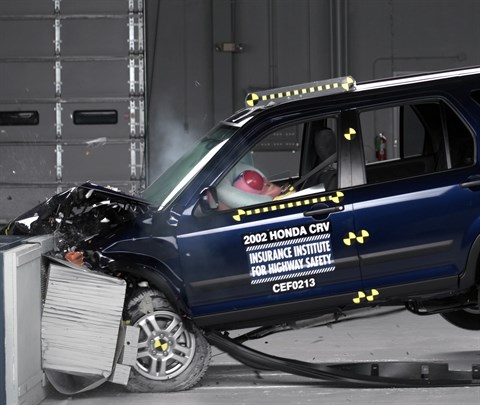
Action shot taken during the frontal offset crash test.
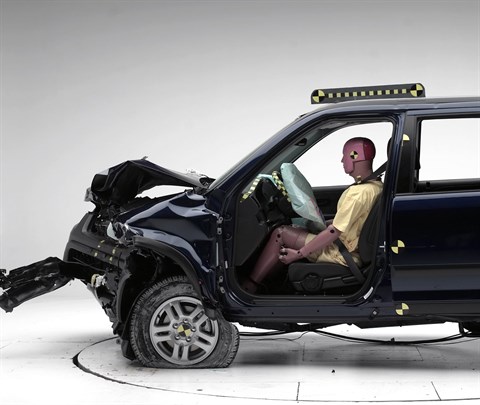
The dummy's position in relation to the steering wheel and instrument panel after the crash test indicates that the driver's survival space was maintained well.
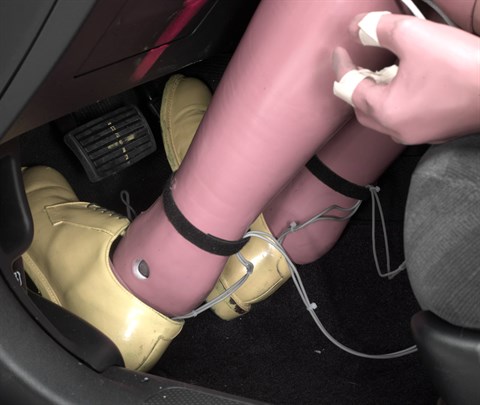
Intrusion into the driver's space was minimal, and all leg and foot measures indicated low risk of injury.
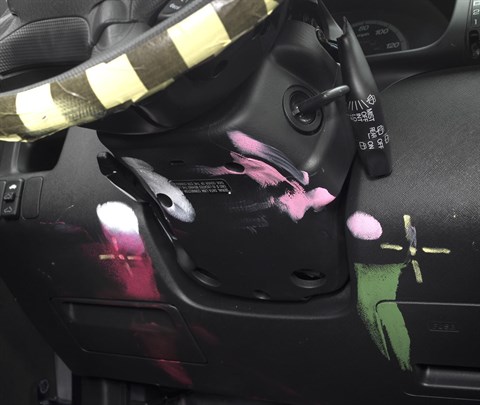
Smeared greasepaint indicates where the dummy's knees and shins hit the knee bolster and steering column.
Measures of occupant compartment intrusion on driver side
| Evaluation criteria | Measurement |
|---|---|
| Test ID | CEF0213 |
| Footwell intrusion | |
| Footrest (cm) | 4 |
| Left (cm) | 6 |
| Center (cm) | 7 |
| Right (cm) | 6 |
| Brake pedal (cm) | 3 |
| Instrument panel rearward movement | |
| Left (cm) | 0 |
| Right (cm) | 0 |
| Steering column movement | |
| Upward (cm) | 5 |
| Rearward (cm) | -3 |
| A-pillar rearward movement (cm) | 1 |
Driver injury measures
| Evaluation criteria | Measurement |
|---|---|
| Test ID | CEF0213 |
| Head | |
| HIC-15 | 248 |
| Peak gs at hard contact | 28 |
| Neck | |
| Tension (kN) | 1.5 |
| Extension bending moment (Nm) | 24 |
| Maximum Nij | 0.30 |
| Chest maximum compression (mm) | 34 |
| Legs | |
| Femur force - left (kN) | 1.6 |
| Femur force - right (kN) | 0.7 |
| Knee displacement - left (mm) | 3 |
| Knee displacement - right (mm) | 0 |
| Maximum tibia index - left | 0.58 |
| Maximum tibia index - right | 0.54 |
| Tibia axial force - left (kN) | 2.8 |
| Tibia axial force - right (kN) | 3.5 |
| Foot acceleration (g) | |
| Left | 78 |
| Right | 86 |
Side: original test
Rating applies to 2005-06 models
Tested vehicle: 2005 Honda CR-V LX 4-door 4wd with standard front and rear head curtain airbags and standard front seat-mounted torso airbags
The Honda CR-V was redesigned for the 2002 model year. Front and rear side head curtain airbags and front seat-mounted side torso airbags became standard beginning with 2005 models, and the B-pillar was strengthened, also beginning with 2005 models. (In 2002-04 models, only front seat-mounted torso airbags were optional and side curtain airbags were not available.)
| Evaluation criteria | Rating |
|---|---|
| Overall evaluation | |
| Structure and safety cage | |
| Driver injury measures | |
| Head/neck | |
| Torso | |
| Pelvis/leg | |
| Driver head protection | |
| Rear passenger injury measures | |
| Head/neck | |
| Torso | |
| Pelvis/leg | |
| Rear passenger head protection | |
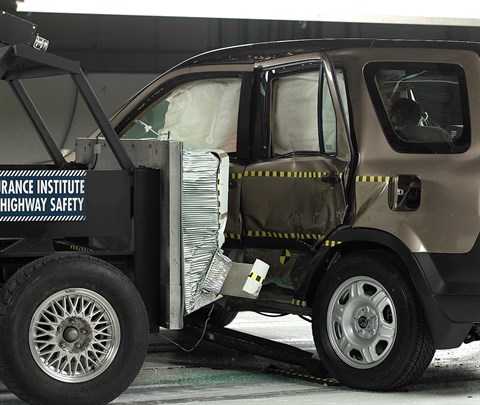
View of the vehicle and barrier just after the crash test.
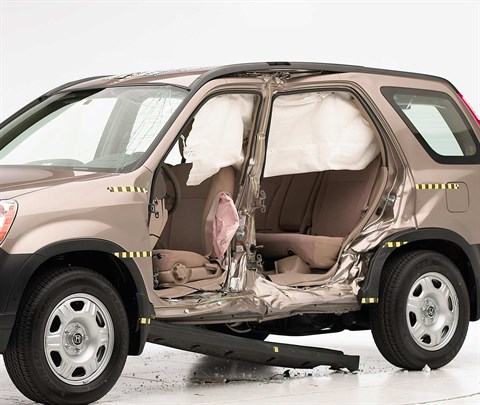
View of the vehicle after the crash with doors removed, showing the side airbags and damage to the occupant compartment.
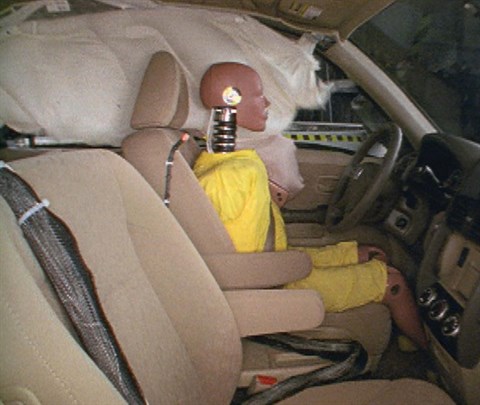
Action shot taken during the side impact crash test showing the driver dummy's head was protected from being hit by hard structures by the side curtain airbag.
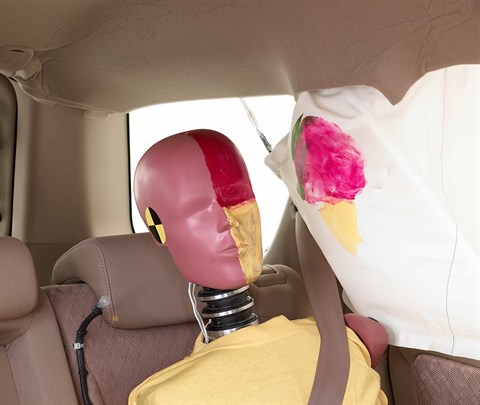
Smeared greasepaint shows where the rear passenger dummy's head was protected by the side airbag.
Measures of occupant compartment intrusion on driver side
| Test ID | CES0425 |
|---|---|
| B-pillar to longitudinal centerline of driver's seat (cm) | -4.0 |
| Negative numbers indicate the amount by which the crush stopped short of the seat centerline. | |
Driver injury measures
| Evaluation criteria | Measurement |
|---|---|
| Test ID | CES0425 |
| Head HIC-15 | 267 |
| Neck | |
| Tension (kN) | 2.0 |
| Compression (kN) | 1.0 |
| Shoulder | |
| Lateral deflection (mm) | 40 |
| Lateral force (kN) | 1.7 |
| Torso | |
| Maximum deflection (mm) | 40 |
| Average deflection (mm) | 28 |
| Maximum deflection rate (m/s) | 4.73 |
| Maximum viscous criterion (m/s) | 0.73 |
| Pelvis | |
| Iliac force (kN) | 0.9 |
| Acetabulum force (kN) | 1.9 |
| Combined force (kN) | 2.4 |
| Left femur | |
| L-M force (kN) | 0.2 |
| L-M moment (Nm) | 64 |
| A-P moment (Nm) | -33 |
Passenger injury measures
| Evaluation criteria | Measurement |
|---|---|
| Test ID | CES0425 |
| Head HIC-15 | 179 |
| Neck | |
| Tension (kN) | 0.1 |
| Compression (kN) | 0.7 |
| Shoulder | |
| Lateral deflection (mm) | 31 |
| Lateral force (kN) | 1.9 |
| Torso | |
| Maximum deflection (mm) | 33 |
| Average deflection (mm) | 27 |
| Maximum deflection rate (m/s) | 3.27 |
| Maximum viscous criterion (m/s) | 0.44 |
| Pelvis | |
| Iliac force (kN) | 1.2 |
| Acetabulum force (kN) | 3.1 |
| Combined force (kN) | 4.0 |
| Left femur | |
| L-M force (kN) | 0.4 |
| L-M moment (Nm) | 68 |
| A-P moment (Nm) | 19 |
Head restraints & seats
Seat type: All seats
| Overall evaluation | |
|---|---|
| Dynamic rating | |
| Seat/head restraint geometry |
| Seat type | All seats |
|---|---|
| Geometry | |
| Backset (mm) | 58 |
| Distance below top of head (mm) | 45 |
| Seat design parameters | |
| Pass/fail | Fail |
| Max T1 acceleration (g) | 10.6 |
| Head contact time (ms) | 93 |
| Force rating | 3 |
| Neck forces | |
| Max neck shear force (N) | 210 |
| Max neck tension (N) | 1,139 |
About the head restraint & seat test
Currently, IIHS tests apply only to front seats.
